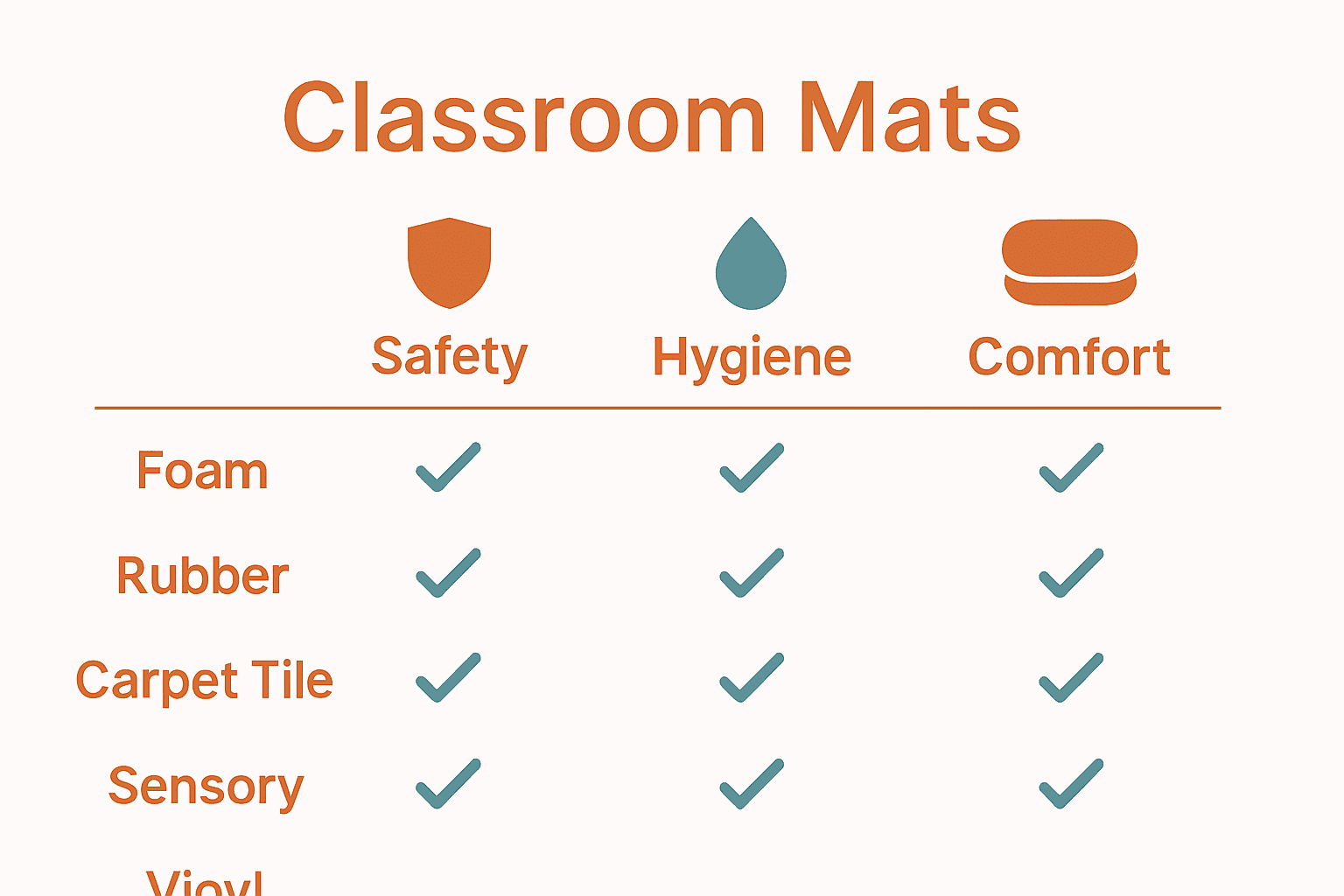Nearly half of teachers say flexible classroom setups improve student engagement. Classroom mats have become much more than simple floor coverings in schools. They are game changers that help create interactive zones, boost safety, and make learning more comfortable for kids of all ages. By choosing the right mats, educators can support different learning preferences, meet safety standards, and even promote their school’s unique identity in every classroom.
Table of Contents
- Defining Classroom Mats And Core Applications
- Classroom Mat Types And Material Options
- Key Features: Safety, Hygiene, And Comfort
- Customisation, Branding, And Sizing Solutions
- Compliance Standards And Cost Considerations
Key Takeaways
| Point | Details |
|---|---|
| Purpose of Classroom Mats | Classroom mats enhance learning environments by providing defined spaces, safety, and support for various learning styles. |
| Types and Materials | Schools can choose from interlocking foam, rubber, carpet tiles, sensory mats, and vinyl options based on specific needs and activities. |
| Safety and Comfort Features | Modern classroom mats emphasize safety with slip-resistant materials, hygiene through easy cleaning, and comfort for floor-based activities. |
| Customisation and Compliance | Customisation options enable schools to reflect their identity, while adhering to compliance standards ensures safety and long-term value. |
Defining Classroom Mats and Core Applications
Classroom mats represent specialised floor coverings designed to transform educational spaces into dynamic, interactive learning environments. Classroom mats are purpose-built floor solutions that go beyond traditional flooring, enabling schools to create versatile, engaging spaces that support multiple learning styles and pedagogical approaches.
According to loopermagazine, these innovative floor coverings are instrumental in making education a “hands-on, engaging experience” by removing physical barriers and enabling more collaborative, movement-based learning. By strategically implementing classroom mats, educational institutions can support kinesthetic learners and facilitate interactive teaching methods that enhance student participation and understanding.
Classroom mats serve multiple core applications within educational settings:
- Learning Zone Demarcation: Creating defined spaces for different activities like reading corners, group work areas, and quiet study zones
- Safety Enhancement: Providing slip-resistant, cushioned surfaces that reduce injury risks during physical activities
- Acoustic Management: Absorbing sound to create quieter, more focused learning environments
- Comfort Improvement: Offering soft, supportive surfaces that make floor-based learning more comfortable
- Sensory Learning Support: Offering textured surfaces that can aid sensory processing and motor skill development
These versatile floor solutions are not merely decorative elements but strategic educational tools that can significantly impact classroom dynamics, student engagement, and overall learning experiences. By understanding the multifaceted role of classroom mats, schools can make informed decisions about creating more adaptive, responsive learning spaces.
Classroom Mat Types and Material Options
Classroom mats come in a diverse range of types and materials, each designed to meet specific educational environment needs. Classroom flooring solutions range from soft foam tiles to durable rubber surfaces, offering schools multiple options for creating adaptive, functional learning spaces.
Understanding the nuanced requirements of different classroom activities, manufacturers have developed specialised mat types to support various educational approaches. Schools can now select from a comprehensive array of mat options that address safety, comfort, acoustics, and learning style requirements.
The primary classroom mat types include:
- Interlocking Foam Mats: Soft, cushioned tiles that can be easily configured for different learning zones
- Rubber Activity Mats: Durable, non-slip surfaces ideal for physical education and high-traffic areas
- Carpet Tiles: Modular flooring options that provide sound absorption and comfort
- Sensory Integration Mats: Textured surfaces designed to support students with specific learning or sensory processing needs
- Multipurpose Vinyl Mats: Waterproof, easy-to-clean surfaces suitable for art, science, and messy learning activities
For schools seeking versatile flooring solutions, understanding different entrance mat types can provide additional insights into material selection and functional design. Material considerations should prioritise durability, ease of cleaning, safety features, and the specific learning activities planned for each educational space.
When selecting classroom mats, educational institutions must balance multiple factors including budget, maintenance requirements, student safety, and pedagogical objectives. The right mat can transform a standard classroom into a dynamic, interactive learning environment that supports diverse educational approaches and student needs.

Key Features: Safety, Hygiene, and Comfort
Classroom mats are engineered to provide a comprehensive solution addressing three critical educational environment requirements: safety, hygiene, and comfort. These essential features ensure that learning spaces remain protected, clean, and conducive to student well-being and educational engagement.
According to earlylearningfurniture, advanced classroom mats now incorporate sophisticated design elements like anti-slip Rhombus backing, which guarantees safe use across different surface types. This technological innovation addresses one of the primary concerns in educational settings - preventing accidental slips and falls that could potentially harm students.
Key safety and comfort considerations for classroom mats include:
- Impact Absorption: Minimising injury risks during physical activities
- Non-Slip Surfaces: Preventing accidental slips in high-movement areas
- Hygienic Materials: Resistant to moisture, bacteria, and easy to clean
- Thermal Insulation: Providing comfortable flooring during floor-based activities
- Acoustic Dampening: Reducing noise levels in dynamic learning environments
As spaces4kids highlights, modern classroom mats offer versatile solutions like wipe-clean, urine-resistant surfaces that are specifically designed for indoor and outdoor use.
These mats can range from 25mm to 40mm in thickness, providing schools with flexible options to meet specific safety and comfort requirements.
Understanding how to create safe learning environments becomes crucial when selecting classroom mats. Schools must carefully balance material durability, hygiene standards, student comfort, and budget constraints to create optimal learning spaces that support both physical safety and educational effectiveness.

Customisation, Branding, and Sizing Solutions
Classroom mat customisation represents a strategic approach for schools to create unique, purpose-driven learning environments that reflect their institutional identity and specific educational requirements. Modern mat solutions offer unprecedented flexibility in design, size, and branding opportunities that go far beyond traditional flooring options.
Schools can transform standard floor coverings into powerful communication tools through strategic customisation. By incorporating institutional logos, colour schemes, and specific dimensional requirements, educational institutions can create mats that not only serve functional purposes but also reinforce school branding and create a cohesive visual identity.
Customisation options for classroom mats include:
- Logo Integration: Embedding school crests or institutional emblems
- Colour Matching: Aligning mat colours with school colour palettes
- Size Flexibility: Creating mats tailored to specific classroom dimensions
- Modular Design: Configurable mat systems that adapt to different learning zones
- Material Specialisation: Selecting surfaces optimised for specific activities
Understanding made to measure mats becomes crucial for schools seeking precise flooring solutions. Professional mat providers can craft bespoke designs that meet exact specifications, ensuring perfect integration with existing classroom infrastructure.
By leveraging advanced customisation technologies, schools can create mat solutions that are not just functional floor coverings, but strategic assets that enhance learning environments. The ability to personalise mats allows educational institutions to create spaces that are both practical and inspirational, supporting diverse learning styles while maintaining a consistent institutional aesthetic.
Compliance Standards and Cost Considerations
Navigating the complex landscape of classroom mat compliance requires schools to carefully balance safety regulations, budget constraints, and educational functionality. Educational institutions must ensure that their flooring solutions meet stringent safety standards while providing cost-effective, long-term value for their learning environments.
According to spaces4kids, comprehensive mat compliance involves multiple critical safety specifications. Professional classroom mats must meet rigorous standards such as EN71 certification, fire retardant requirements, and specific material safety guidelines including being phthalate-free, CFC-free, and constructed with flame-resistant materials like CMHR soft foam.
Key compliance and cost considerations include:
- Safety Certification: Ensuring mats meet EN71 Parts 1, 2, and 3 standards
- Material Quality: Selecting waterproof, urine-resistant, and easy-to-clean surfaces
- Durability Assessment: Evaluating long-term performance versus initial investment
- Maintenance Costs: Calculating cleaning, replacement, and repair expenses
- Installation Requirements: Considering professional fitting and potential additional infrastructure needs
As earlylearningfurniture highlights, reputable manufacturers typically provide a manufacturer’s warranty, which can serve as an additional assurance of product quality and compliance. Schools should view mat investments not just as immediate purchases, but as strategic long-term assets that contribute to safe, engaging learning environments.
Ultimately, successful mat selection requires a holistic approach that considers regulatory compliance, budget limitations, and educational outcomes. By prioritizing safety standards and understanding total cost of ownership, schools can make informed decisions that protect both their students and their financial resources.
Enhance Classroom Safety and Comfort with Custom Mats from Mats4U
Creating a safe, engaging, and comfortable classroom environment is essential for effective learning. This article highlights the importance of specialised classroom mats that support safety, hygiene, and interactive learning zones. At Mats4U, we understand the challenges schools face when balancing durability, comfort, and compliance while fostering dynamic educational spaces.
If you are looking to transform your school environment with versatile and customisable mats, our collection of Indoor Entrance Mats offers slip-resistant, durable solutions suitable for educational settings and high-traffic areas.

Take the next step to enhance your school’s floor coverings today. Explore bespoke mat options crafted to your exact needs and bring safety and style to every classroom. Visit Mats4U now to find quality mats that meet your educational goals and compliance standards.
Frequently Asked Questions
What are the main applications of classroom mats in educational settings?
Classroom mats are used for learning zone demarcation, safety enhancement, acoustic management, comfort improvement, and sensory learning support, transforming classrooms into engaging environments.
What types of materials are classroom mats made from?
Classroom mats come in various materials, including interlocking foam, rubber, carpet tiles, sensory integration mats, and vinyl, each designed for specific educational activities and environments.
How do classroom mats enhance safety in schools?
Classroom mats enhance safety by providing slip-resistant surfaces, impact absorption for injury prevention, and hygiene features that make them resistant to moisture and bacteria, ensuring a safe learning environment.
Can classroom mats be customized to meet specific needs?
Yes, classroom mats can be customized with features like logo integration, color matching, size flexibility, and material specialization, allowing schools to create tailored solutions that reflect their branding and educational requirements.









